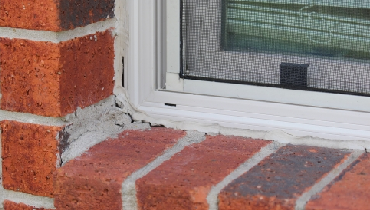Areas in Your Home Where You Should Not Caulk

It’s amazing how applying a little caulk in certain areas around your home can save you from the hassle of expensive repairs. Caulking is not only extremely helpful around the house, but its multipurpose use also makes it a DIY necessity.
However, one of caulks' greatest assets, its multipurpose use, can also be its biggest drawback. This is because many people make the mistake of overusing it or apply it in places where it shouldn’t go. One reason for this is there simply isn’t enough good information about when and how to use caulk. In this article, we’ll review some of the worst places to use caulk and why.
Where not to Caulk Around Windows
Window caulking is one area where many people make a caulking mistake. Caulking around windows is fine, but you have to be careful you don’t use too much and end up sealing your window shut. Here are some areas around your window to avoid caulking:
Weep Holes: Weep holes are tiny holes on the inside of your window frame that allows moisture to escape. It’s important to keep the weep holes in your window frame open to keep moisture from building up at the bottom of your windowsill. Caulking over weep holes won’t allow moisture to escape, which could end up rotting your windowsill and frame.
Moving parts: Anything that moves on your window should be avoided when it comes to caulking. The opening/closing mechanism, the ledge of the window frame, and anywhere that the window touches when it’s closed are places to stay away from if you want your window to open and close properly.
Trimmed out windows: Trimmed-out windows are common in newer homes and are designed to sit above the siding rather than in or on it. People mistakenly believe that the gaps around trimmed out windows need to be caulked, but they don’t. Caulking these areas can potentially trap moisture in between the trim and the window and cause mold and mildew to form.
Storm windows: Storm windows are a little trickier when it comes to caulking. While it’s ok to caulk the top and the sides of them, you should never caulk around the bottom of a storm window. You shouldn’t do this for the same reasons that you avoid caulking weep holes. Moisture accumulates during the winter on the inside of storm windows. Caulking the bottom won’t allow moisture to drain and could cause mold, mildew, and rotting of the windowsill and frame.
Where not to Caulk for Your Exterior
Bottom edges of soffit and fascia joints: There are times when soffit and fascia don’t do a good job of redirecting rainwater away from your home. When this happens, water runs out the bottom side of the soffit and fascia. If you caulk this area, water will get trapped inside the soffit and fascia, which can cause water and/or mold damage to your home.
Wood to metal joints: Any type of wood to metal joint shouldn’t be caulked because it will increase the risk of water damage. Wood to metal joints already have predesigned areas of water drainage and moisture prevention buildup. Caulking them can create a bigger problem later.
Trim boards on top of siding: Trim boards on top of your siding are specifically hung and installed to direct the flow of water away from the siding. Therefore, there’s no reason to caulk the trim boards because doing so can do more harm than good. Again, restricting or altering the natural design features is not a good idea.
Bottom of siding boards: If water happens to find its way behind your siding, then you want to make sure it has a place to escape. Caulking the bottom of the siding boards can trap water between the siding and your house, which is never a good thing. This buildup of water can eventually lead to rot, mildew, and/or mold developing where you can’t see it.
Siding nails: Caulking your siding nails is an unnecessary eyesore that should be avoided. Your siding overlaps in a way that the nails aren’t at risk of causing water damage. If for some reason you need to remove your siding, having it caulked can make the removal process even more difficult, and you might damage the siding doing it.
What About My Bathroom?
Your bathroom is one of the best places to use caulk as long as it’s used in the right places. Bathroom and shower caulk can help improve the look and functionality of your bathroom but using it incorrectly can also cause some major problems.
Avoid caulking any areas that can trap water or restrict its ability to escape. Water buildup anywhere in your bathroom can lead to the development of mold and mildew, and in some cases cause rotting around windows and doors. Also, don’t caulk plumbing fixtures or areas that have moving parts like hinges or sliding shower doors.
When Should I Recaulk?
Now that you know what to caulk, determining how often you need to caulk is the next challenge. A visual inspection is usually the best way to determine if new caulk is needed. Once caulk starts to become discolored, cracks or begins to develop gaps, it’s time to remove it and recaulk. If you need help, call the pros at your local Mr. Handyman. We can help you with caulking and any other home projects you need to get done. Give us a call or submit a request online today!
 Click to call
Click to call


